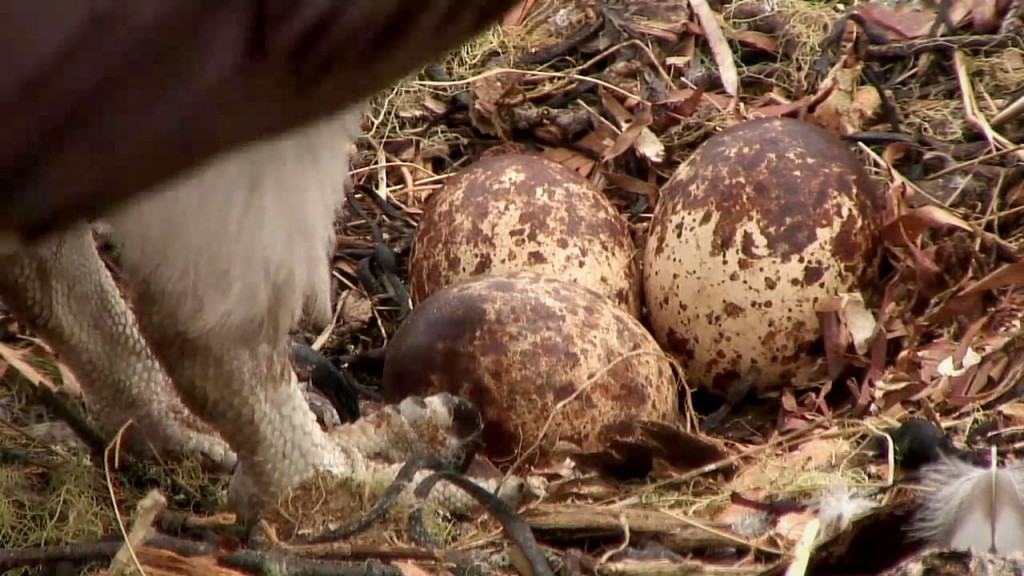Hog Island Ospreys Rachel and Steve are getting ready for their three chicks to hatch. They’ll soon feed and shelter the young ones until the chicks are ready to fledge out on their own. For more on mating, incubating, and hatching, here’s osprey expert Dr. Rob Bierregaard to answer your raptor-related questions!
Q. Is Steve unusual in that he has quite the affinity for brooding the eggs?
Nope, we’ve seen this before. Some males don’t seem interesting in incubating at all, and at other nests the females have to muscle her way back to the eggs.
Q. What is the likely hood of Rachel and Steve’s past babies returning to their parents nest?
Non-zero. It could happen. I don’t know of any documented cases. More likely to be males than females, as the females disperse more than males. This is nature’s way of keeping the gene pool mixed up.
Q. Do female ospreys go through menopause like humans do? Is there an approximate age when the females will not be fertile anymore?
Female Ospreys in their mid-teens tend to show a decreased reproductive output, but a 27-yr old female in Scotland was 27 when she last bred (last year). She raised a remarkable 50 young over her lifespan and went through 5 or 6 males, if I remember correctly.
Q. Why might an osprey egg not be fertile?
An egg might not be fertile if the sperm didn’t do their job. Maybe a young pair not very good at the complicated balancing act involved in avian copulation, or maybe the female’s old and her ovaries are wearing out. Lots of reason. All that said, most eggs will be fertile.
Q. Harriet at Dunrovin nest lost her mate last year. What would have happened to her if she was not able to find a mate? Would she abandon the nest and move on or continue to stay alone at her current nest?
She would most likely stay at that nest and hope a male would show up to take it over. But if no male did appear, she would wander around and if she found some hunky young male doing a courtship “sky dance” over a new nest with a big juicy fish in his talons, well, she just might see stars in her eyes.
Q. How long does it take for the female to allow another male to mate with her?
She wouldn’t waste any time. While we say Ospreys mate for life, I think it’s better to think of them bonding to a nest, rather than another individual. Both birds will return to the same nest each spring from wherever they spent their winters (not the same place). If one doesn’t get back, the one who does will immediately start courting with any bird that attracts them. Often they may get started courting with a new bird and then their old mate will arrive and chase the new bird away.
Q. What are the major current changes that the Osprey are evolving through now, such as weather, diet conditions effects, etc. ?
Ospreys are remarkably flexible. Coastal birds especially change their diet through the season as different fish species migrate into and out of their hunting ranges. They’ll feed heavily on alewives or herring when they find a run and then shift over to menhaden when they come in. 30 years ago flounder were a real staple in their diet. Then we overfished the flounder stock (big surprise!) so now they don’t catch as many flounder, but they’ve shifted to other species and are doing fine, as we see from the continued growth of the population across the country.
Q. Will you speak to the danger posed to Osprey by all the trash we see in so many of the nests ? Do they try to eat it or does the plastic ever suffocate them?
The big danger is discarded fishing line. We have gruesome pictures of both young and adults hanging from nests, entangled in fishing line. As for trash bags, they’re very unlikely to suffocate, but they can sometimes get tangled in them. They wouldn’t try to eat them. So just take care not to leave these sort of things out in the environment.
Q. How heavy a fish can a full-grown Osprey carry back to its nest?
A female Osprey weighs about 4 pounds. She might be able to carry a 2 pound fish.



